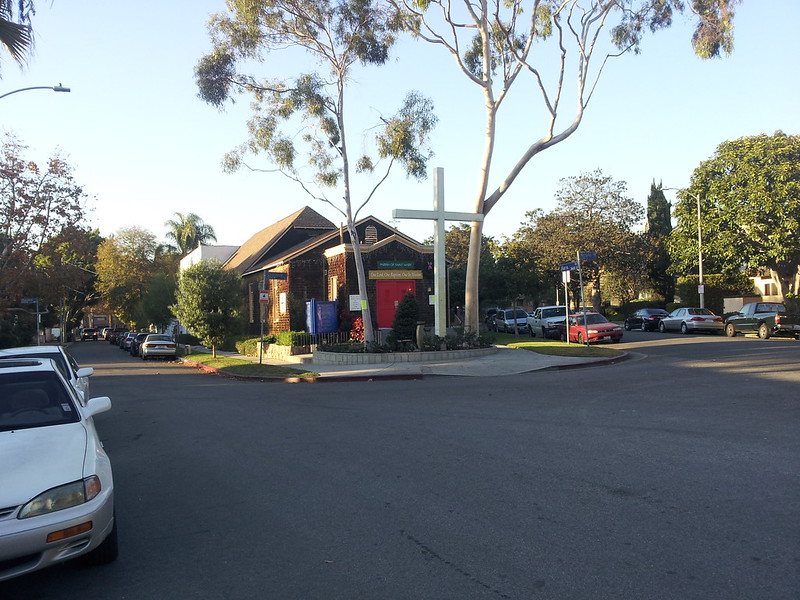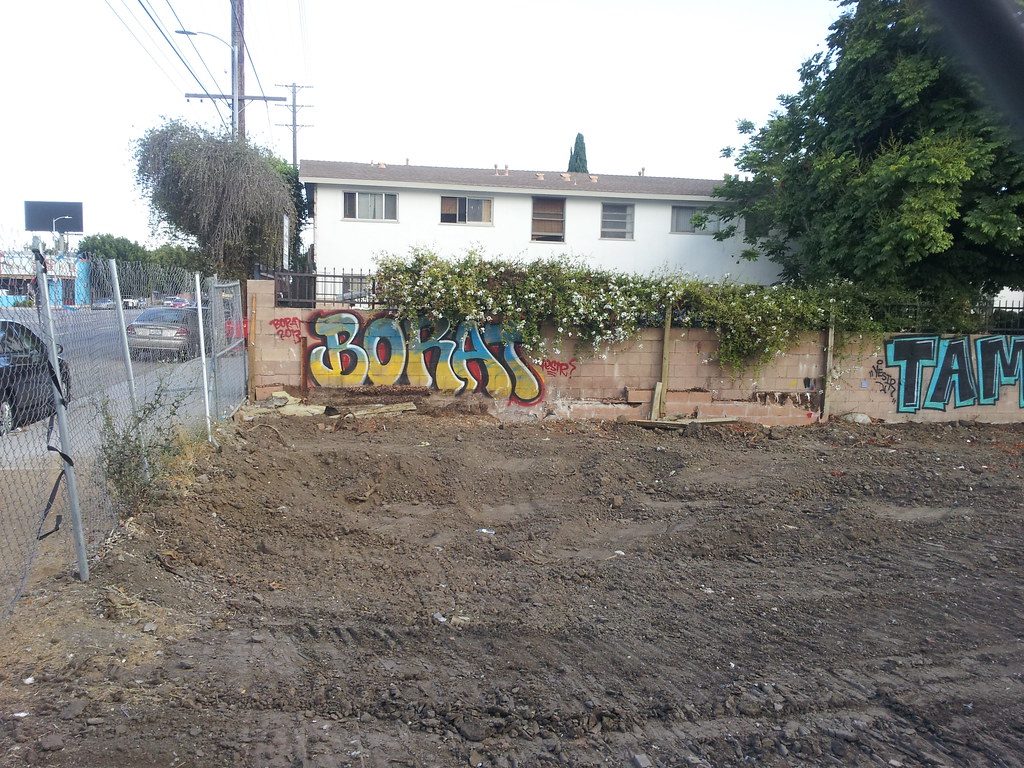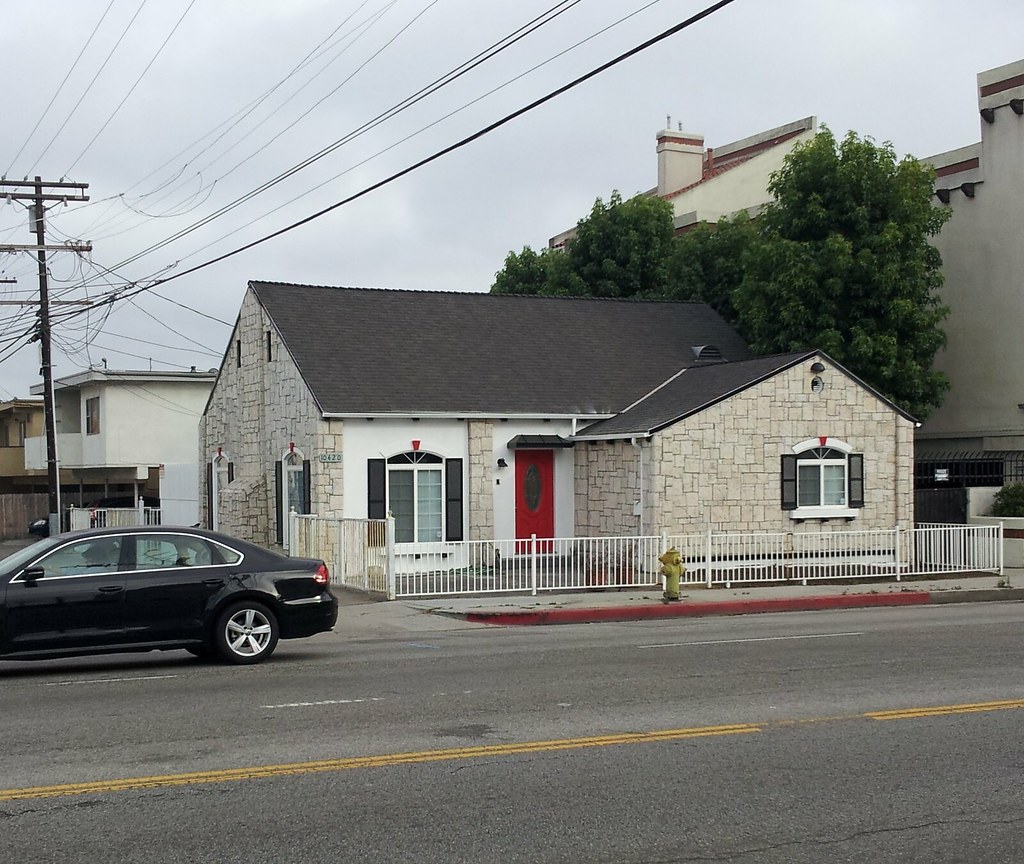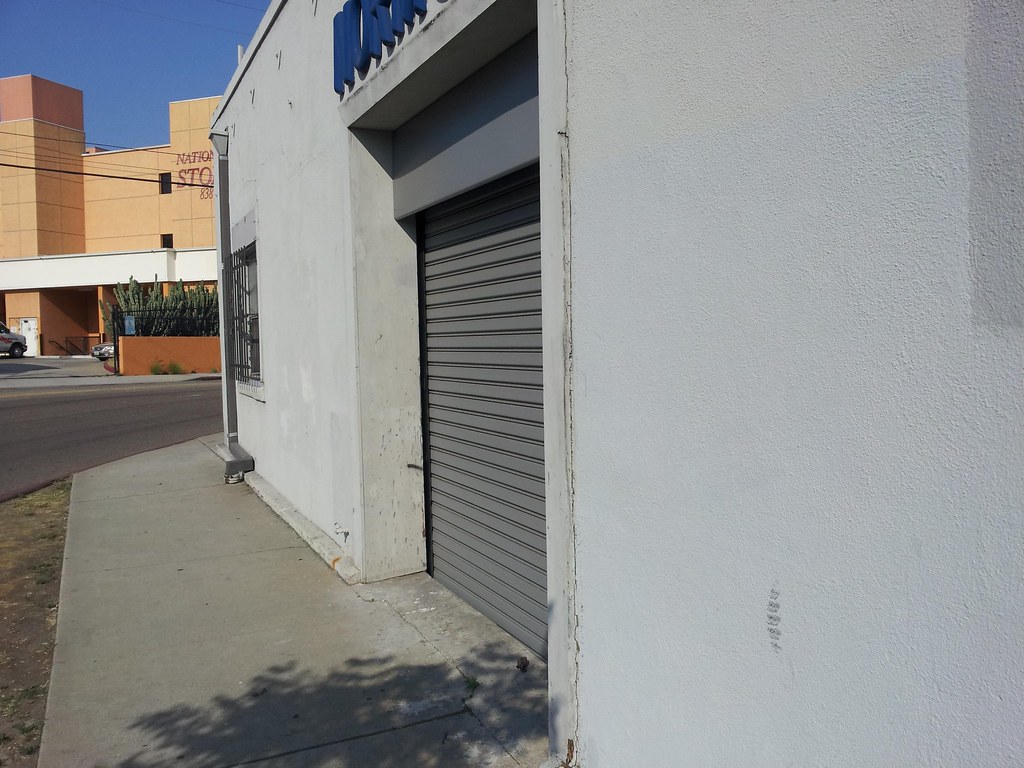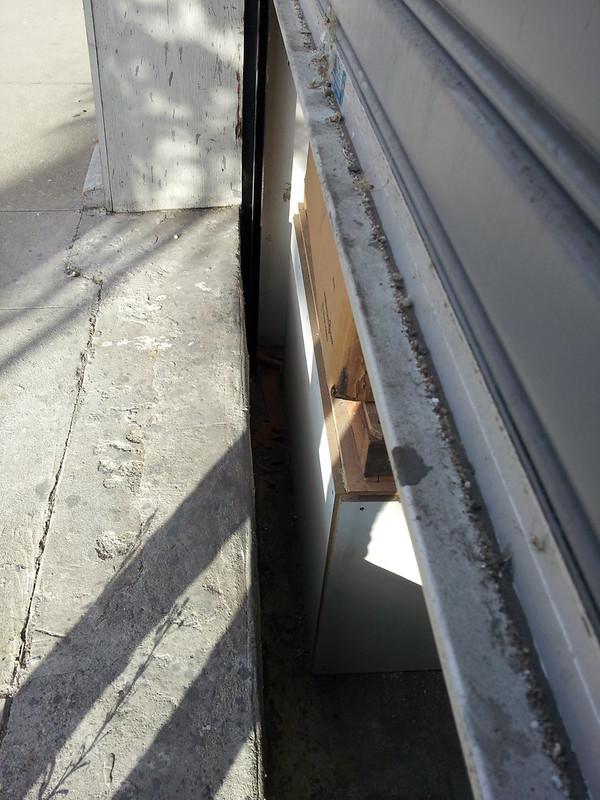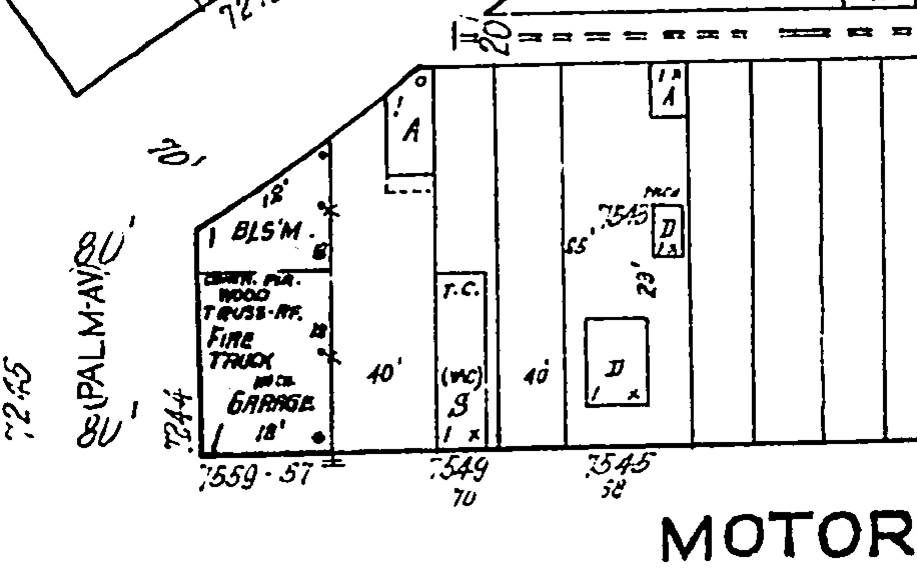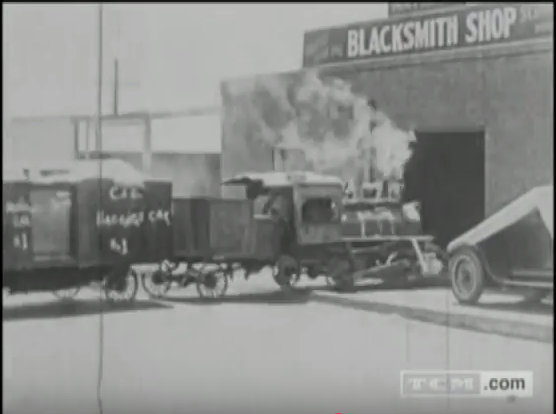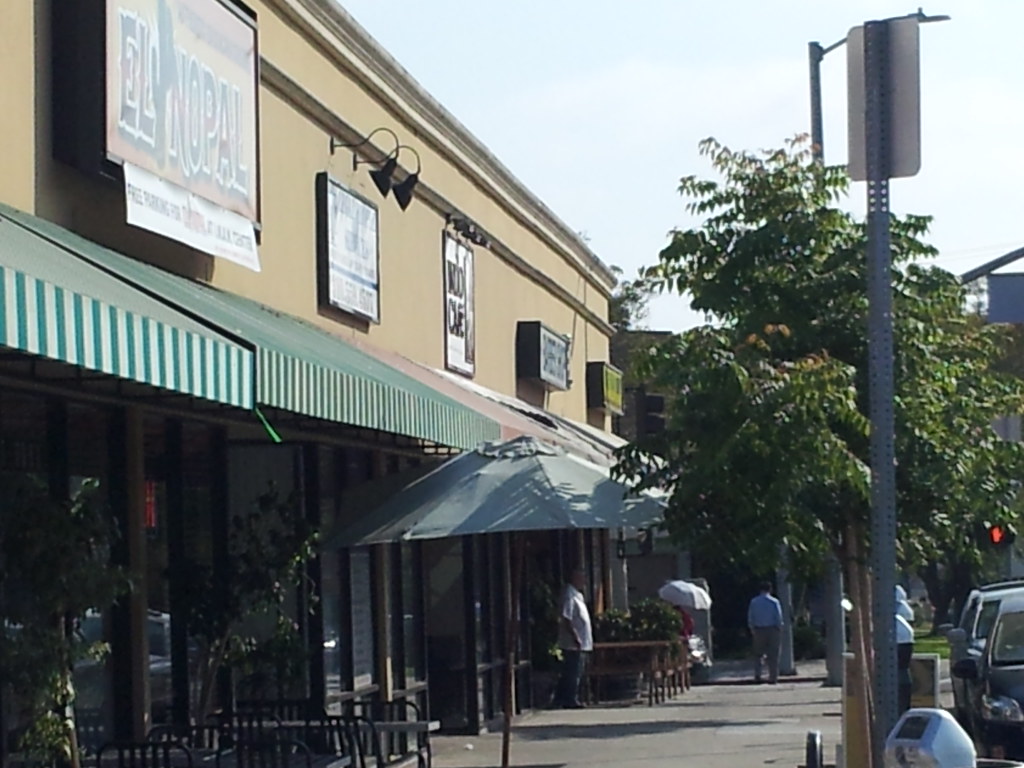Imagine, if you can, that you are walking through a quiet residential neighborhood in L.A. Although most of the housing supply takes the form of mid-20th-Century dingbat style apartment buildings, there are a few old houses extant, here and there. As these neighborhoods go, it's reasonably peaceful and attractive, not least because of the mature and leafy trees that line the sidewalks. There are few if any outward signs of urban decay, crime, or other social ills. As you read this, imagine peppy-go-lucky 1960s sitcom theme-type music playing in the background.
There's an attractive church in the neighborhood, Saint Mary in Palms.
I like the way it's sited on the gore point of a three-way intersection, giving it a sort of East Coast small-town feel.
If this were New York or Boston, this little intersection might well have some charming appellation like Saint Mary Square; after all, what is Times Square really but the intersection of Broadway and Seventh? But we don't generally name things in this town unless it's either absolutely necessary or someone's generosity is in need of acknowledgement. That's L.A. for you. Instead of Saint Mary Square or Tabor Triangle we have The Intersection Of Watseka Avenue And Faris Avenue Where That Church Is.
Mature broadleaf trees shade the quiet streets...
and many of the extant single-family houses exhibit considerable variety in their design. Mature broadleaf trees shade the quiet streets...
You walk further, continuing to hear 1960s sitcom music in your head, and you come across another church, belonging to the Seventh Day Adventist Reform denomination.
There's nothing particularly interesting about the siting or architecture of this house of worship, but around the corner you find this curious holiday display.
 |
| Let it flock, let it flock, let it flock! |
First of all, the snow. Can I say one thing about it? Fake snow on a sunlight-dappled Southern California Lawn is the sort of thing that gives this city a bad name. Secondly, the characters are worth a closer look. Charlie Brown, Linus, and Snoopy stand forth for the renowned comic strip and animated cartoons, although only Snoopy looks particularly happy--ironically so, as we'll see. I don't think the kid bundled up in the pinkish coat and hat is a Peanuts character--South Park, maybe? And in the background is little Cindy Lou from The Grinch Who Stole Christmas, with Frosty The Snowman rounding out the scene. Clearly, this person has issues with plot continuity, and it's even possible that there's some sort of copyright violation here, what with the random juxtaposition of all these characters.
But whatever; whoever lives here certainly seems to be getting into the spirit of the season, we have to admit.
Still imagining the sitcom sound track, now perhaps with Christmas special episode touches included, you stroll further and find this rather foreboding sign.
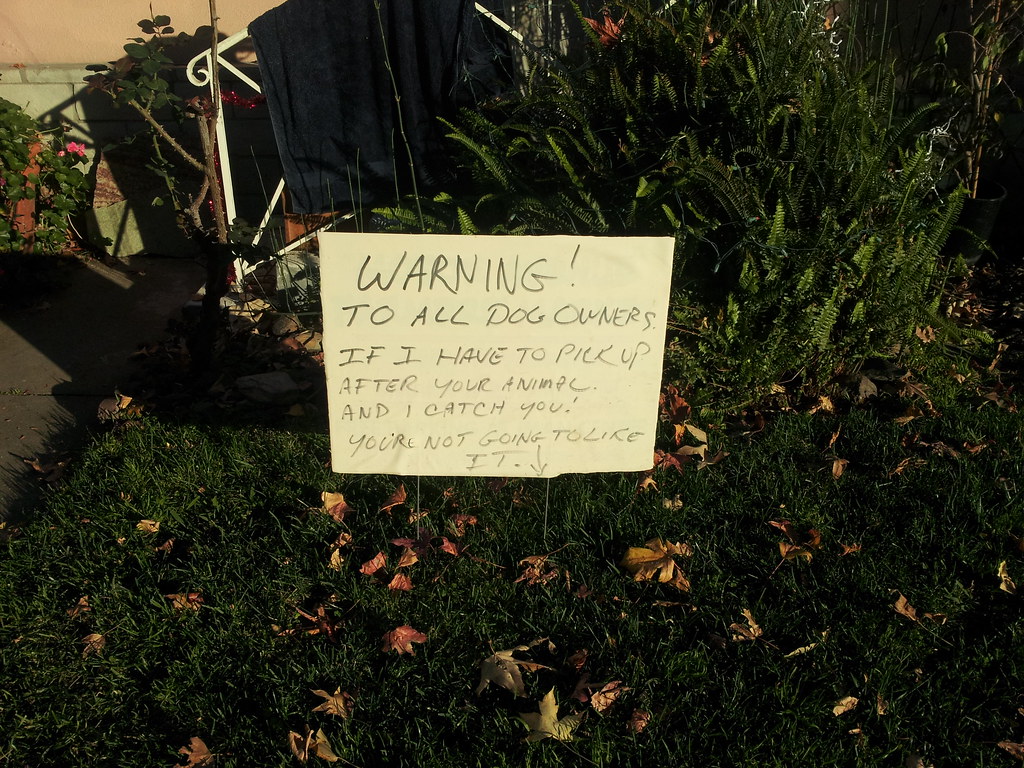 |
| Dog owners are warned! |
WARNING!
TO ALL DOG OWNERS
IF I HAVE TO PICK UP
AFTER YOUR ANIMAL
AND I CATCH YOU
YOU'RE NOT GOING TO LIKE
IT.
IT.
No wonder Charlie Brown looks so miserable. He's counting the seconds until he can get Snoopy out of here. What do you think will happen to Charlie Brown if the occupant of the house does catch him omitting to clean up after Snoopy? Will the resident come out and shout angrily while waving his fist in the air? Will Charlie Brown get captured on a webcam and reported to the authorities? That could be, but not judging from what we see a few paces further on:
The sign on the lower left is particularly grim, not to mention callous in the disregard it exhibits for the neighbors, for example the church. What's more, Sunday morning -- or in this case I guess it would be Saturday morning--churchgoers have to pass by this as they enter and leave the church grounds.
Granted, these signs are addressed to anyone who may be thinking of committing robbery, although those who may be considering mere burglary would be unwise to assume that the occupant of this property is aware of the legal distinction between burglary and robbery. On the other hand, while the householder almost certainly comprehends the difference in magnitude between robbery and canine elimination free-range enabling, he clearly has a temper. "Move along, as quickly as possible" is what Charlie Brown's closest friends would advise.
Just outside the right frame of the picture above is the parking lot for the Adventist church, because its property wraps around the one occupied by the gun aficionados. I had to make sure, by checking the county parcel database, that the two parcels are indeed separate, and this was a good thing. It would have been disheartening to learn that the Adventists had abandoned their pacifist principles.
It turns out that this isn't the end of it. The blocks in this neighborhood are oddly shaped, so only a little further on is yet another corner. On this spot is the house of another firearms expert, proclaimed as follows:
The wording here is considerably more restrained. Be that as it may, here in one small residential block we have multiple signs warning burglars and robbers that they may be shot, and of those, two seem to be aiming the gun at any and all onlookers. I have to wonder what happened at these two houses, almost next door to each other, and next door to a church yet, that these signs are considered necessary. A good security system and burglar alarm would probably be more effective.
 |
| Y'all can just go rob someone else! |
Granted, these signs are addressed to anyone who may be thinking of committing robbery, although those who may be considering mere burglary would be unwise to assume that the occupant of this property is aware of the legal distinction between burglary and robbery. On the other hand, while the householder almost certainly comprehends the difference in magnitude between robbery and canine elimination free-range enabling, he clearly has a temper. "Move along, as quickly as possible" is what Charlie Brown's closest friends would advise.
Just outside the right frame of the picture above is the parking lot for the Adventist church, because its property wraps around the one occupied by the gun aficionados. I had to make sure, by checking the county parcel database, that the two parcels are indeed separate, and this was a good thing. It would have been disheartening to learn that the Adventists had abandoned their pacifist principles.
It turns out that this isn't the end of it. The blocks in this neighborhood are oddly shaped, so only a little further on is yet another corner. On this spot is the house of another firearms expert, proclaimed as follows:
The wording here is considerably more restrained. Be that as it may, here in one small residential block we have multiple signs warning burglars and robbers that they may be shot, and of those, two seem to be aiming the gun at any and all onlookers. I have to wonder what happened at these two houses, almost next door to each other, and next door to a church yet, that these signs are considered necessary. A good security system and burglar alarm would probably be more effective.
